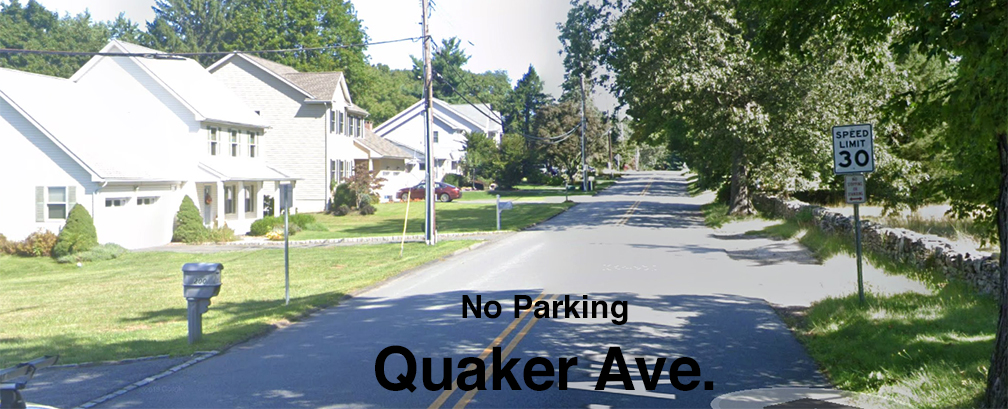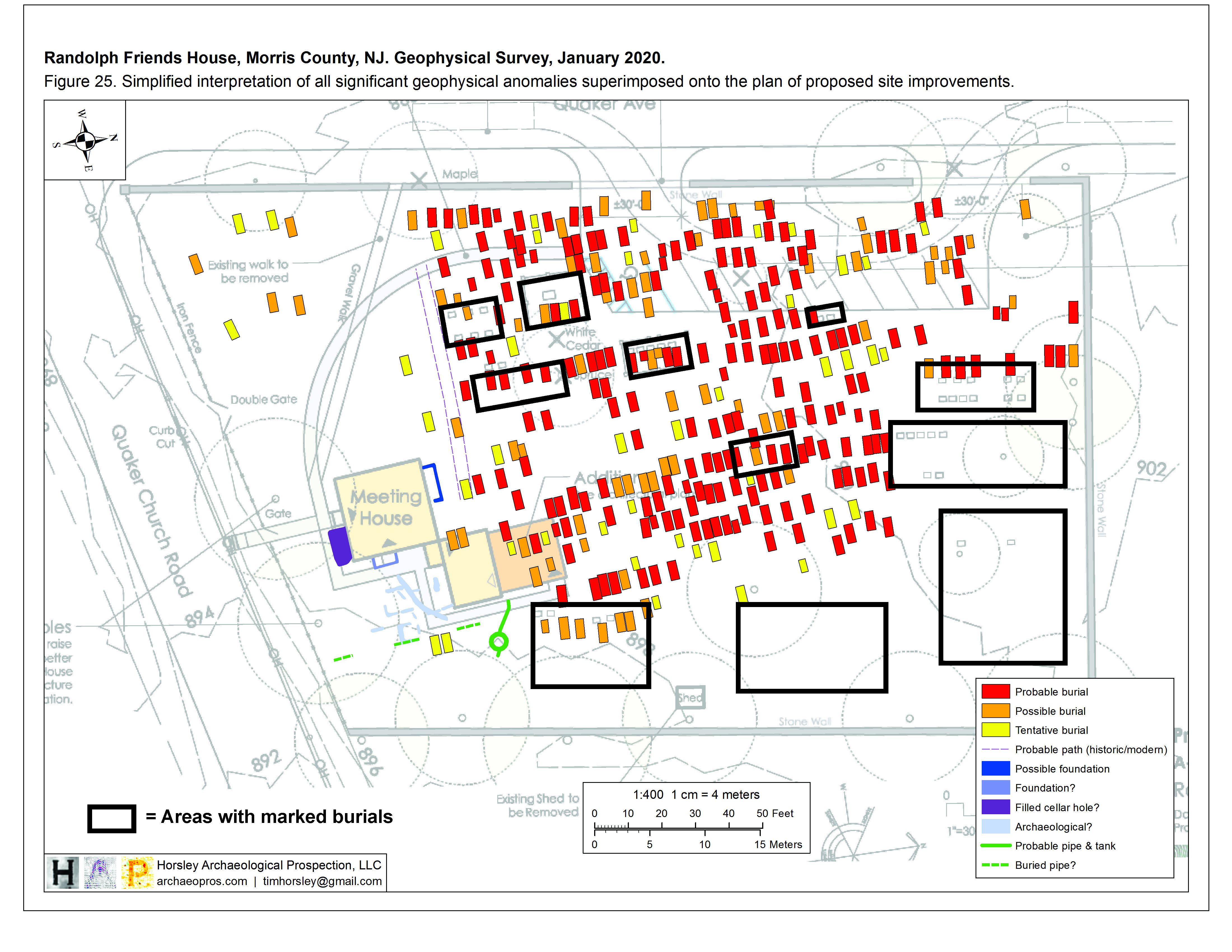Cemetery Archaeological Investigation
The lack of adequate parking at the Meeting House and Cemetery is a major obstacle to public access. The Association is therefore considering adding on-site parking in a portion of the Cemetery that has no marked graves.

As a historic property that has received both County and State funding, any excavation on the Meeting House property must meet historic preservation standards. One of those standards requires the investigation of areas that will be impacted by excavation work to determine if they contain historical materials. For the Cemetery, this obviously means investigating to find out if there are any unmarked burials.
The Association has long known that there are unmarked burials on the site. The early Quakers did not believe in marking graves and there is documentary evidence of about 40 burials on site prior to the 1840s, when markers became accepted. To determine whether there might be other unmarked burials, as part of the development of a new preservation plan in 2019, the Association contracted with Horsley Archaeological Prospection, LLC to conduct a ground penetrating radar study.
The study was undertaken in Janaury 2020 and tentatively identified ca. 300 unmarked grave shafts. Some of those shafts were in the areas where parking and new ADA compliant paths were tentatively planned. Therefore, before any work could be undertaken to install parking and new paths, an archaeological survey was needed to assess the depth of the burials and the extent of human remains.
The required achaeological survey, which is funded by grants from Morris County and the State of New Jersey, started on Monday, January 11 and will take about three weeks. This page will be updated on a regular basis and include the final results when they are submitted.
 January 2020 Ground penetrating radar results
January 2020 Ground penetrating radar resultsAn initial workplan was developed, setting out a protocol for handling both incidental and insitu human remains. The plan was submitted to the NJ Historic Preservation Office for approval prior to the commencement of any fieldwork. The plan included a figure detailing the locations of proposed excavations. Fieldwork was then arranged with an excavation subcontractor.
The fieldwork begins with the careful removal of grass and topsoil from the proposed parking lot site and limited areas along the proposed pathway using a small backhoe or other excavation equipment. Shovel and trowel are then used to scrape surfaces down to the natural subsoil to expose grave shafts or other features, such as grave marker bases.
A sample of approximately 6 to 12 of the grave shafts will be partially excavated to a depth sufficient to determine the presence or absence and depth of human remains within each shaft. Human remains will be carefully documented but not removed. The grave shafts are then backfilled after examination. No human remains will be removed from site. During the investigation access to the burial ground will be limited to work crews and others associationed with the project. Grave shafts or burials identified will be kept covered when archaeologists are not on site.
At the end of the fieldwork the excavation area will be covered with a permeable geotextile fabric and soil. The affected areas of the Cemetery will be re-landscaped.
Non-grave related artifacts will be taken to a laboratory in Trenton, analyzed and returned once the investigation is completed.
A technical report will be prepared in accordance with the requirements of the NJ Historic Preservation Office. This report will describe the work undertaken and interpret the results. It will specifically address the presence or absence of human remains, their location, and their depth below a relative datum. Recommendations will be offered as to how to avoid or minimize the effects of the proposed parking lot and pathway construction on archaeological remains. The Final Report will be summarized in the FMHCA Newsletter.
The archaeology team from Hunter research arrived on Monday and marked out the first area to be surveyed. The top layers of soil will be carefully removed by machine to locate the top layer of grave shafts.
A new camera to monitor the Meeting House property was installed and connected online, allowing the work to be photographed remotely. By the end of the day, Trench #1 (T1) was opened and prepared for closer inspection.
The opening of Trench #1 (T1) continued on Day 3 and Trench #2 (T2) was started. By the end of the day, Trench #1 provided some evidence of burials that will be further investigated.
Trench #2 (T2) was mostly cleared revealing several grave shafts, work started on Trench #3 (T3).
Work continued opening identify grave shafts in T2 and T3 was full opened. At the end of the day, the site was covered and secured.
Work continued identify, clearing and mapping the grave shafts in Trenches #1, #2 and #3. Once the shafts are identified, the are then hand excavated to determine the depth of the burials and the status of any human remains.
The entire project is being filmed by the project team and students at County College of Morris. Detailed pictures and videos will not be posted on this site to respect the privacy of those buried in the Cemetery. More details will be provided when a final report is prepared by the archaeological team.
Attention turned to the excavation 5-7 grave shafts to determine the depth of burials and the condition of any remains.
Each shaft is carefully dug by hand. Some of the soil is sifted to make sure no disarticulated remains (separated from the main skeleton) are missed. Articulated remains are studied in place before the soil is returned and the shaft covered.
The first evidence of skeletal remains was found about 4 feet below the surface. The remains are examined in place and will covered without moving once their condition is assessed. The entire process is carefully photographed for later study. The team also uncovered a shroud pin, which was photographed but not moved.